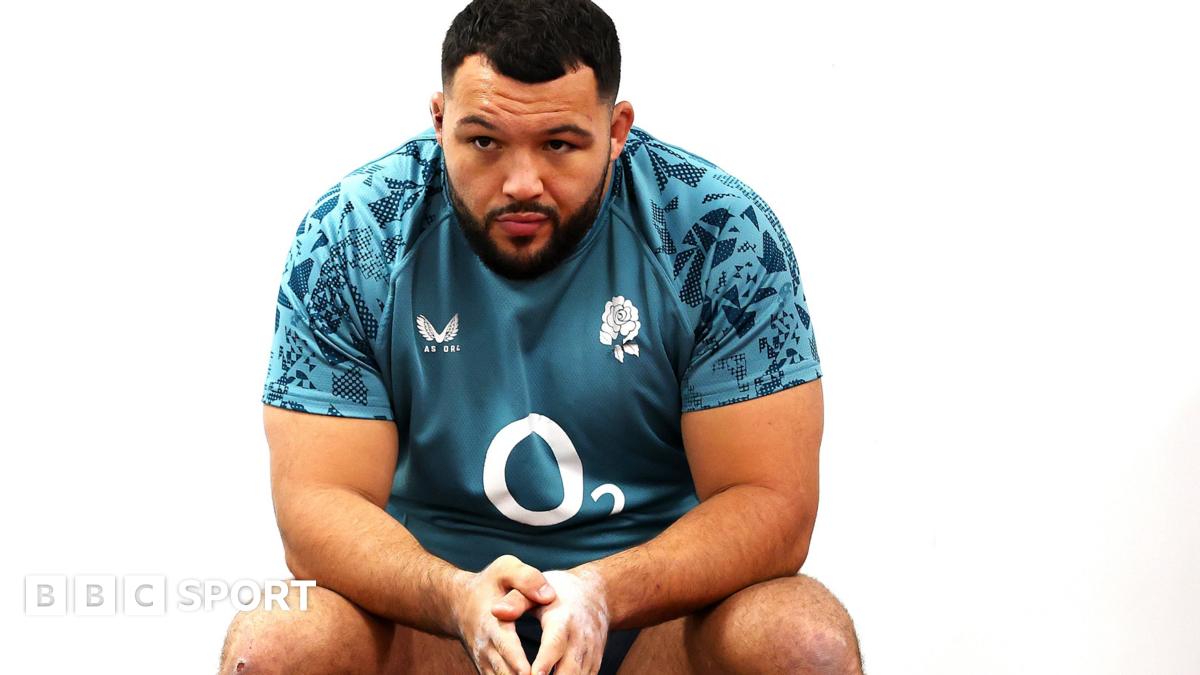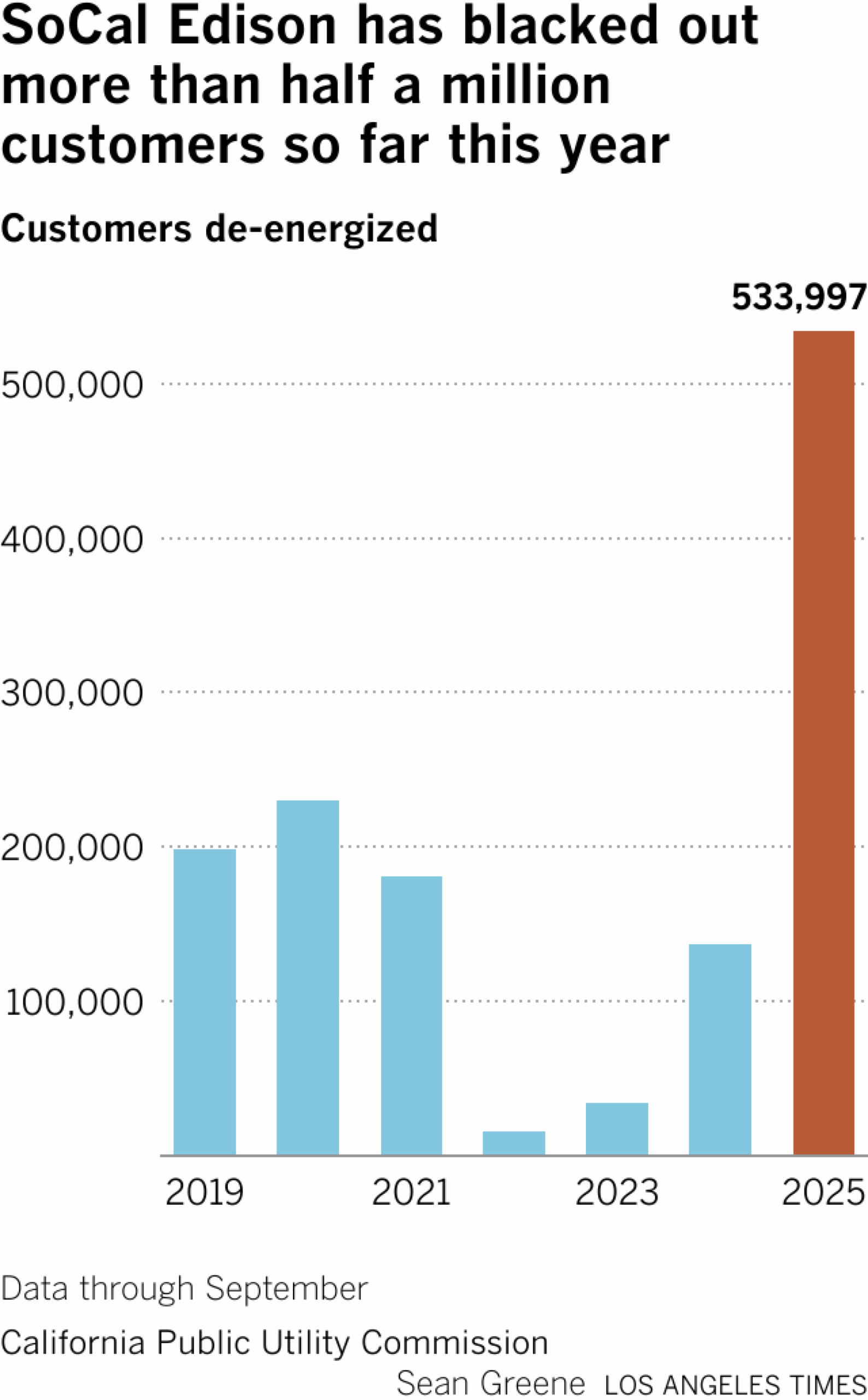Southern California Edison has cut power to hundreds of thousands of its customers this year, more than ever before, as it attempts to stop its electric lines from sparking wildfires.
The utility has told communities in fire-prone areas in recent weeks that they should expect more of the power shutoffs than in prior years and that the outages could last for longer periods of time.
The Rosemead-based company said it had lowered the wind speed that triggers the blackouts, and added tens of thousands of customers to the areas subject to them, after the devastating Jan. 7 Eaton fire. The inferno, which killed 19 people in Altadena, ignited in high winds under an Edison transmission line.
“You should be ready for the power to cut off at any moment,” Ian Anderson, a government relations manager for Edison, told the Moorpark City Council at an October meeting. He urged residents to buy generators and said the utility doesn’t reimburse customers for spoiled food and other losses if it believes the blackouts were required by “an act of God.”
“But PSPS is not an act of God,” responded Moorpark Councilmember Renee Delgado, using the acronym for public safety power shutoffs. “It’s a choice SCE is making.”
For more than a decade, California utilities have used the shutoffs to stop their equipment from sparking fires. The intentional outages have become so established in California’s wildfire prevention plans that Edison now faces lawsuits saying that it failed to shut off some of its lines before the Eaton fire.
Yet in recent months, the utility has heard a chorus of complaints from communities including Moorpark and Malibu that it is blacking out customers even when the winds are calm. And the utility often has failed to warn people of the coming outages, making it impossible for them to prepare, according to filings at the state Public Utilities Commission.
“You guys have put us into a Third World situation,” Scott Dittrich, a resident of Malibu, said at a Sept. 30 meeting that the city had with Edison to address the shutoffs.
Kathleen Dunleavy, an Edison spokeswoman, said the company recognizes that “any power outage is a hardship.”
But the outages are needed because they have prevented fires in dangerous weather, she said. “Our commitment is to keeping our communities safe,” she added.
This year, Edison has cut off 534,000 customers to prevent fires, according to data it filed with state regulators. That’s almost four times the 137,000 customers subject to the blackouts in 2024.
Under state rules, utilities can use the outages only as a measure of last resort — when the risk of electrical equipment igniting a fire is greater than the dangerous hazards the blackouts cause.
Disconnecting a neighborhood or city can cause far more than just inconvenience.
Traffic lights no longer work, causing perilous intersections. During a Dec. 10 outage in Moorpark, a utility truck failed to stop at a nonworking light on State Route 118, crashing into a sedan. The driver was injured and had to be extracted from the truck by emergency responders, according to the city’s report to state regulators.
The shutoffs also leave residents who have medical problems without the use of needed devices and refrigerators to store medications.
And they can cut off communication, stopping residents from getting evacuation warnings and other emergency messages.
During the Eaton and Palisades fires, the power shutoffs, as well as outages caused by wind and fire damage, “significantly disrupted the effectiveness of evacuation messaging,” according to a recent review of Los Angeles County’s emergency performance.
In the last three months of last year, Edison received 230 reports of traffic accidents, people failing to get needed medical care and other safety problems tied to the shutoffs, according to the company’s reports.
Dunleavy said Edison turned off the power only when staff believed the risk of fire exceeded the outages’ consequences.
Nonetheless, Alice Reynolds, president of the Public Utilities Commission, told Edison last month that she had “serious concern” about how the utility was leaving more customers in the dark.
Reynolds wrote in a letter to Steve Powell, the utility’s chief executive, that records showed that the company de-energized not just a record number of residential customers in January, but also more than 10,000 crucial facilities such as hospitals. The longest blackout lasted for 15 days, she said.
“There is no question that power outages — particularly those that are large scale and extended over many days — can cause significant hardship to customers, jeopardizing the safety of customers with medical needs who rely on electricity and disrupting businesses, critical facilities, and schools,” she wrote.
Reynolds said she would require Edison executives to hold biweekly meetings with state regulators where they must show how they planned to limit the scope and duration of the blackouts and improve their notifications to customers of coming shutoffs.
Powell wrote back to her, acknowledging “that our execution of PSPS events has not always met expectations.”
“SCE remains committed to improving its PSPS program to help customers prepare for potential de-energizations and reduce the impacts,” he wrote.
Since 2019, Edison has charged billions of dollars to customers for wildfire prevention work, including increased equipment inspections and the installation of insulated wires, which it said would reduce the need for the shutoffs.
Just four months before the Eaton fire, at an annual safety meeting, Edison executives told state regulators that the utility’s fire mitigation work had been so successful that it had sharply reduced the number of shutoffs, while also decreasing the risk of a catastrophic wildfire by as much as 90%.
A year later, at this year’s annual safety meeting in August, those risk reduction estimates were gone from the company’s presentation. Instead, Edison executives said they expected the number of shutoffs to increase this year by 20% to 40%. They added that the average size of the areas subject to the outages could be twice as large as last year.
The executives blamed “below average rainfall and extended periods of high winds” for increasing the risk that the company’s equipment could start a fire.
“The weather is getting more difficult for us,” Jill Anderson, Edison’s chief operating officer, said at the meeting.
Some customers have questioned whether the utility’s increasingly unreliable electricity lines should be solely blamed on the weather. They say the shutoffs have seemed more and more random.
The Acton Town Council told the utilities commission in January that Edison was blacking out residents when dangerous conditions “do not exist.”
At the same time, the council wrote, Edison had cut power to neighborhoods served by wires that had been undergrounded, an expensive upgrade that Edison has said would prevent the need for the shutoffs.
Edison’s Dunleavy said that although the Acton homes in those neighborhoods were served by underground lines, they were connected to a circuit that had overhead lines, requiring them to be turned off.
“We try to reroute as much as possible to minimize disruptions,” she said.
At the Moorpark City Council meeting, residents spoke of how the repeated outages, some lasting for days, had caused children to miss school and businesses to close their doors and lose revenue.
The residents also spoke of how their electric bills continued to rise as they had spent more days in the dark.
Joanne Carnes, a Moorpark resident, told Anderson, Edison’s government relations manager, that her last monthly bill was $421.
“Why are we paying more than a car payment,” she asked, “for a service that is not able to provide power?”

